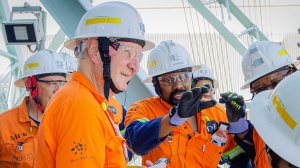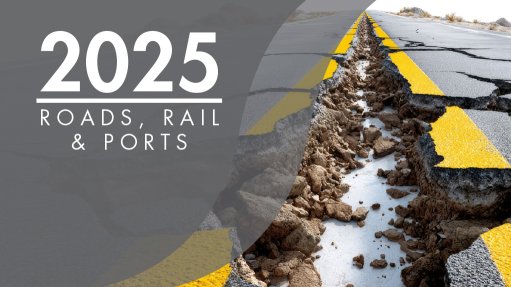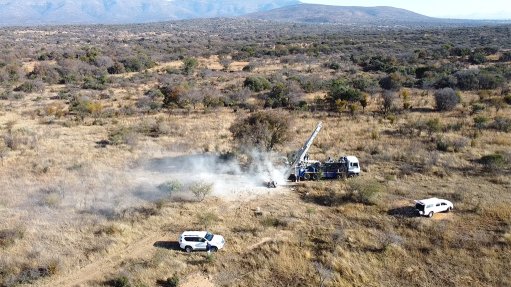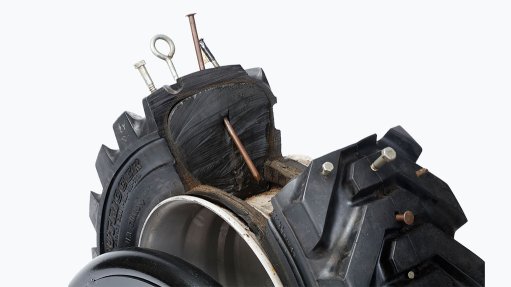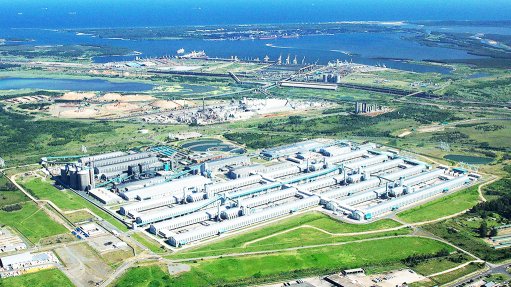Venetia mine is sparkling as brightly as the diamonds it brings to surface

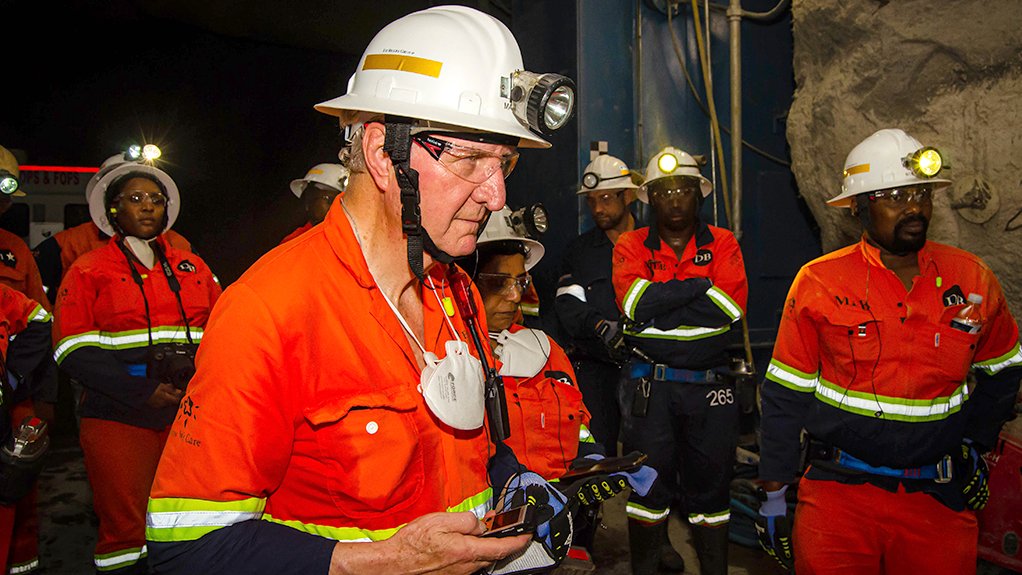
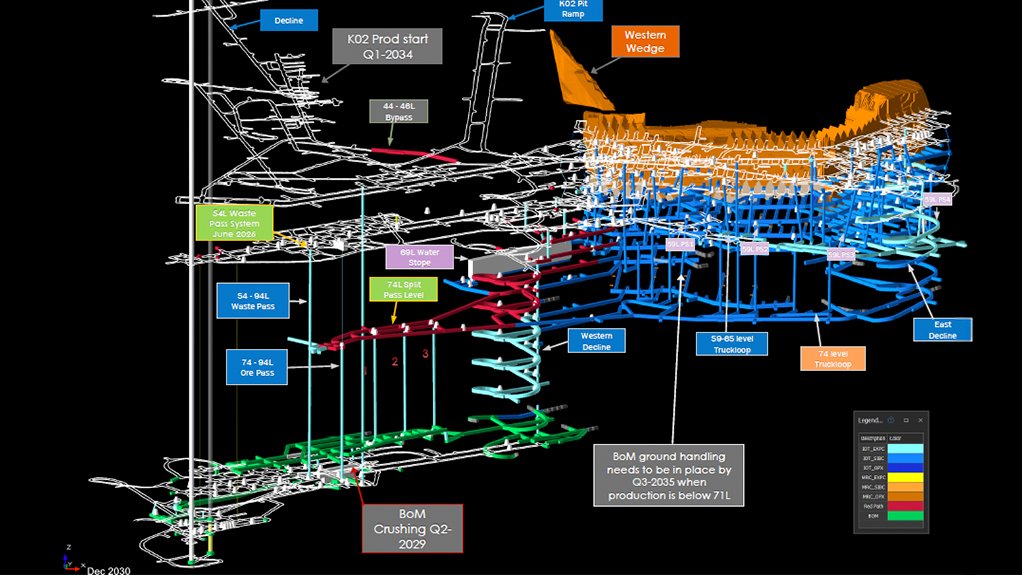
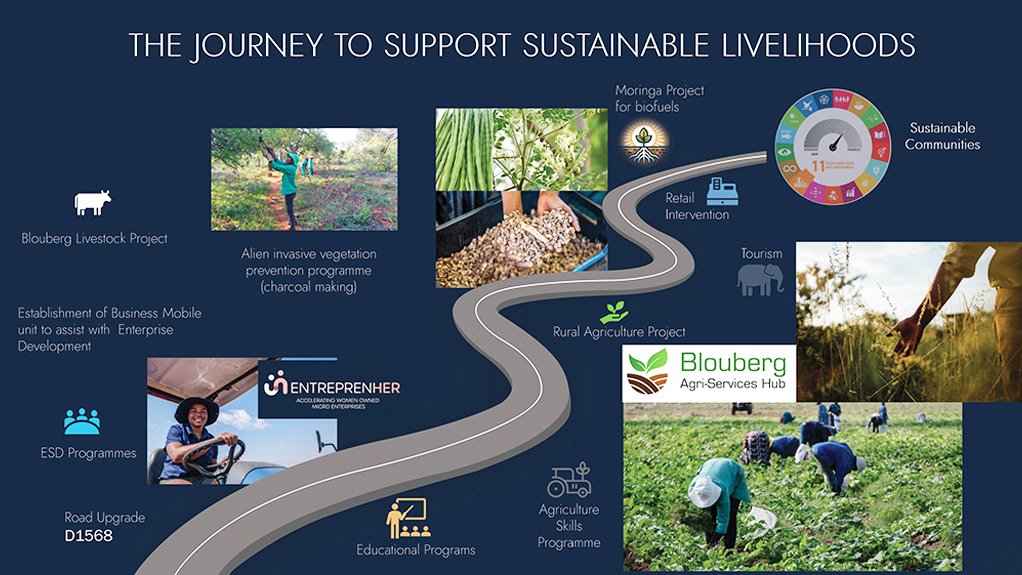
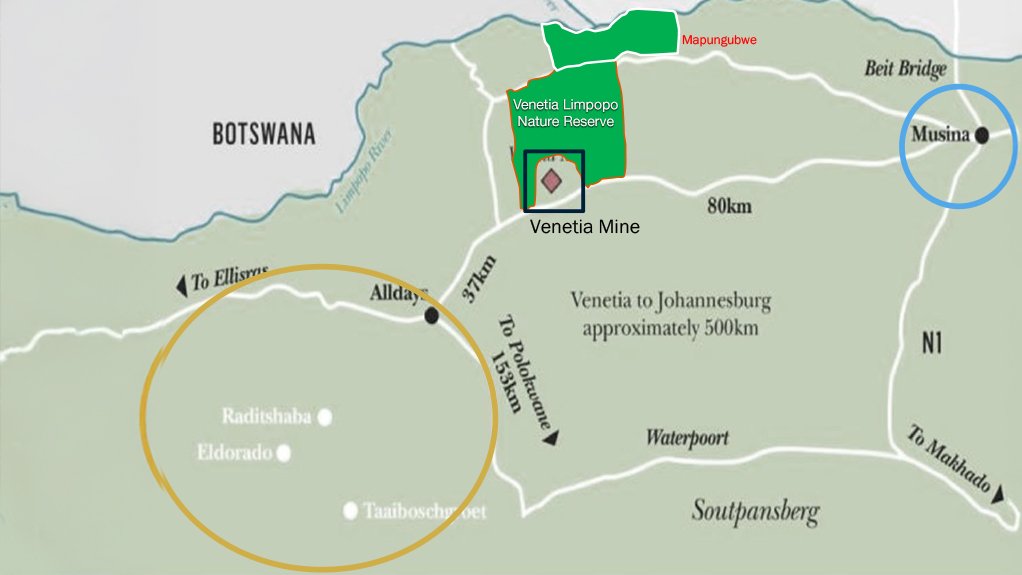
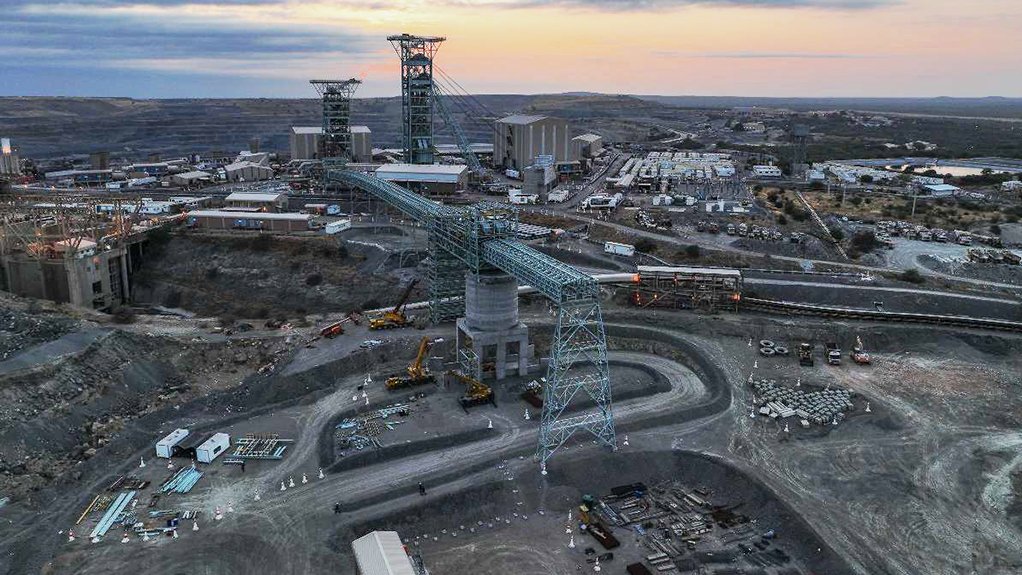
Venetia Diamond Mine executives interviewed by Mining Weekly's Martin Creamer. Video: Shadwyn Dickinson.
Mining Weekly’s Martin Creamer underground.
Venetia mine’s underground design.
Venetia’s support for the host community.
The mine, Venetia Limpopo Nature Reserve, and Mapungubwe National Park.
Venetia mine’s surface infrastructure.
VENETIA DIAMOND MINE (miningweekly.com) – The successful transition from opencast mining to underground mining is being achieved with considerable aplomb at Venetia Diamond Mine, which Mining Weekly has just visited.
De Beers’ $2.3-billion investment in the Venetia underground project, in Limpopo province, represents the biggest single investment in South Africa’s diamond industry in decades.
Stay-in-business capital of $0.6-billion extends to 2027, with no investment needed into Venetia’s large processing plant, coping as it does with the feed of six-million tonnes a year, from which 4.5-million carats of diamonds will be recovered annually. (Also watch attached Creamer Media video.)
Underground infrastructure includes two vertical shaft systems for personnel transport, ore transport and the routing of services, as well as lateral access to stations on level 54 – to which Mining Weekly descended – level 91 and level 94 for the services shaft, and the station on level 100 for the production shaft.
The service shaft has an internal diameter of 7 m and will eventually provide all the services and people transport for the underground workings. The production shaft, with the same internal diameter, is fitted with two rock winders, each having two 24 t payload skips.
Presently, Venetia is processing lower-grade surface stockpiles while the operation transitions and that will continue as the underground production slowly ramps up.
Mining underground until 2049 is expected to yield 81-million carats of diamonds from 115-million tonnes of diamondiferous material.
Reductions in the mine’s carbon footprint will be realised when Envusa Energy’s renewable-energy projects are operational. Envusa Energy, a joint venture between Anglo American and EDF Renewables, aims to establish a regional renewable-energy ecosystem in South Africa to meet the group’s long-term power requirements.
Located 32 km south of the Limpopo river, Venetia is the only remaining diamond mining operation of the De Beers Group in South Africa and has been this country’s largest producer of diamonds since 1995.
Back in the day, De Beers at some stages probably had about nine to 11 operations in South Africa and all of those operations have been sold. There are still legacy closure footprints, such as Voorspoed in the Free State, the Big Hole of Kimberley, and Namaqualand on the West Coast.
At Venetia, sampling began in 1969, opencast development in 1990, opencast mining from August 1992 to December 2022, and underground mining has been proceeding since 2023.
With ramp-up of the underground to six-million carats a year having been slowed to 2032, the life-of-mine now extends to 2049.
The 17-person leadership team that has emerged from the resizing process is now implementing the new underground ramp-up projection.
During opencast mining, a very good 101 grade was achieved and the 838-million tonnes of ore and waste moved yielded 143-million diamond carats.
Venetia senior GM Ntokozo Ngema, Venetia GM underground and projects Jan Nel and Venetia senior mining manager Thabo Mokone outlined the next chapter of Venetia’s journey to Mining Weekly.
They led us through the Integrated Operations Centre (IOC) and thereafter up the production shaft headgear, which provided an overview of the mine’s infrastructure, taking in the large plant, primary crusher, primary stockpile, secondary and tertiary crusher, water recovery, primary and secondary scrubbing, fines and coarse dense media separation, and diamond recovery. Noteworthy is the mine’s dry tailings dam.
The descent down the mine in the cage highlighted that safety is front and centre of the underground environment, which is reflected by the mine achieving 13-million fatality-free shifts.
We witnessed the IOC helping to advance safety still further, along with efficiency and automation. One automated machine is nearing completion of commissioning for operation in sublevel caving, most of the fleet is automation-ready, and communication infrastructure is being put in place to move to the next level of autonomous mining.
The IOC’s environmental system monitors harmful gasses to a point where re-entry after blasting is only permitted once the control room declares the mine safe.
To ensure constant ventilation system back-up, two of six vent systems are kept on standby.
The IOC’s system that caters for breakdowns enables continuous communication to take place about general underground activities, fleet performance, and end-of-shift discussion.
Underground dewatering is IOC-monitored to ensure that water goes to where it should.
A radar system at the openpit reports high-wall movement as it happens.
Weather monitoring follows four stages based on the mine’s emergency flood evacuation TARP system. The first green stage allows the mine to be run normally. The second yellow stage gives the alert for preparation to take place in the event of an impending storm in 12 to 48 hours. The third orange stage signals that personnel and trackless mobile machinery (TMM) must be removed from underground in 12 hours, and the fourth red stage sounds the alarm for personnel to be removed in zero to two hours and TMM to be left behind.
Driver fatigue is managed in real time and alerts are provided if drivers experience micro sleeps or fall asleep on surface.
THE KIMBERLITE OREBODIES
Two kimberlite orebodies – K01 and K02 – will be mined to depths of up to 1 000 m and 700 m, respectively.
K01, which measures 550 m x 120 m, will be the source of most production, generating an average of 3.5-million carats a year from about 4.5-million tonnes of material.
K02, which measures 200 m x 300 m, will be the source of about one-million carats a year from 1.5-million to 2.5-million tonnes of material.
The combined six-million tonnes of kimberlite ore a year will yield four-million carats of diamonds a year.
THE MINING METHOD
Sublevel caving, from which material will be extracted from K01 and K02, is a top-down mining method that involves ore being drilled and blasted from the 'sublevel' production drives developed into the orebody.
The sublevels at Venetia are at 25 m intervals and the rock around the orebody as well as unmined ore is allowed to collapse naturally.
Cave production follows draw control requirements to ensure high ore recovery, low dilution and sufficient cover of broken rock above working levels for the prevention of mud rush/push and airblast.
MINE BUILD-OUT
Mine build-out involves the development of accesses along with ground-handling, power, ventilation, and ore-driving draw points. Ground support is installed in the drives with brow stability during production. Ore drives are mined to design, to assist production drilling set-up accuracy.
The spacing of ore drives is 17.5 m centre-to-centre for first two levels and is at 20 m centre-to-centre for the lower levels.
Long-hole fan drilling involves 16 holes at 89 mm diameter, 2.3 m burden and 35 m maximum hole length.
Generally, 89-mm- to 115-mm-diameter holes are used in sublevel caving with good fragmentation and complete ring breakage being critical for draw control. Full ring breakage must be achieved to avoid formation of bridges or rib pillars.
Uphole charging of blast holes is taking place and emulsion-type explosives are used to match hole retention capability.
Ring blasting is generally restricted to a single ring because of the confined blasting conditions not having the free void to blast into, and the rings have a high powder factor in the blast design owing to the constricted blasting conditions.
FLOOD CONTROL DOORS
Large flood control doors are activated in the event of water inflows exceeding the capacity of the underground pumping system. The doors are designed to seal off the ‘dry’ side of the mine, where the water pumps and other critical infrastructure are located, from the ‘wet’ side of the mine, where the mining of the kimberlite pipes takes place.
In the event of flooding, everyone proceeds to the dry side of the mine and the flood control doors are locked.
Before production begins on any level, flood control doors are built into excavations that are roughly 9 m high by 9 m wide.
The water door seen by Mining Weekly had a steel frame 8 m high, 8 m wide and 1 m thick and was anchored into the host rock by 40 mm steel anchors, 234 in total.
The completed structure, which has 60 t of steel and 80 m3 of concrete, is used to seal the area around the door to create a watertight interface between the door and the host rock.
Steps have been taken to ensure that only water that falls into the centre of the openpit goes underground, while in the pit itself, rain water next to the high walls flows into two sumps before being pumped back to surface.
Visible during Mining Weekly’s descent to 54 level were six 2.8 MW clear water pumps able to move more than a million litres of water an hour. The capacity available can cater for a one-in-200-year flood.
Water reporting deeper into the mine is stored in water stopes – big underground reservoirs – and then pumped back to surface from a pump station.
In January and February this year, the 150-million litres of water that entered the underground was stored in declines before being slowly pumped out through cascading dewatering systems that proved inadequate.
The new infrastructure is able to pump the water directly back to surface and if some water still descends deeper into the mine, that will be stored in the water stopes.
HOST COMMUNITY DEVELOPMENT
Venetia is located between the municipalities of Musina and Blouberg, where most of its approximately 4 000 employees - including contractors – originate. Many of them have been trained in a variety of mining and engineering skills.
Venetia is committed to working with key stakeholders to help build a sustainable future and contribute to a better quality of life for host communities, through the legal requirement of a social and labour plan (SLP), as well as through its Building Forever sustainability programme and corporate social investment.
The projects in the two local municipalities centre on health and wellbeing, education and skills development, economic diversification, and livelihood support.
By 2030, the mine will have supported five jobs offsite for every onsite job.
“The good thing is that we actually achieved that in 2024 through agricultural projects, through our tourism, and through making sure that we upskill the entrepreneurs in the area.
“We’ve supported more than 12 000 sustainable jobs outside the area where we operate and going forward more good projects will continue to be implemented to build on the progress made,” Ngema told Mining Weekly.
Of interest is a biofuel project that Venetia is developing in partnership with Sasol, which will create a new economic zone in the area, where there is also a lot of alien invasive vegetation for the making of charcoal.
“We’ve launched an agricultural hub in Blouberg, and although we have not yet concluded the physical infrastructure for the facility, the hub is already playing a critical role in empowering local farmers and strengthening agricultural activity in the area.
“Besides the very shiny diamonds that we mine here in Venetia, what we do in the community also has a good shine to it and we’re investing a lot to make sure that our community moves forward, even while rough diamond trading conditions remain challenging,” Ngema added.
On the environmental front, projects that have been initiated aim to protect nature. In this regard, the 36 000 ha Venetia Limpopo Nature Reserve has been established next to the mine to accommodate the relocation of plants and animals from the mining licence area. Venetia also shares fences with the Mapungubwe National Park.
CONTRACTORS AND SUPPLIERS
Venetia’s contractors and suppliers include TDS (water doors construction and rim tunnel service); Worley (engineering, procurement and construction management); SRK Consulting (geology and geotechnics); Orica (explosives); SMEI Projects (recovery front-end optimisation – supplied and installed structural steel, mechanical equipment, platework, and piping); Sandvik (automated mining equipment and systems); Redpath Mining (development of the underground mine with the De Beers team, working as the integrated owners team); Zutari, formerly Aurecon (environmental assessment); Howden (underground ventilation); SLR and Envusa Energy (solar PV facility); BBE Projects (air-cooling system); ABB (hoists); Cementation Africa, Master Drilling, Master Splice, Nthambe, Booyco and Louwill Lefa (design, supply conveyors and underground workshop).
De Beers’ global approach to diamond mining spans two continents and four countries – Botswana, South Africa, Namibia and Canada.
Contact Details for Project Information: External communications manager Lesedi Ntuli, tel +27 11 374 7173 or email lesedi.ntuli@debeersgroup.com
Article Enquiry
Email Article
Save Article
Feedback
To advertise email advertising@creamermedia.co.za or click here
Press Office
Announcements
What's On
Subscribe to improve your user experience...
Option 1 (equivalent of R125 a month):
Receive a weekly copy of Creamer Media's Engineering News & Mining Weekly magazine
(print copy for those in South Africa and e-magazine for those outside of South Africa)
Receive daily email newsletters
Access to full search results
Access archive of magazine back copies
Access to Projects in Progress
Access to ONE Research Report of your choice in PDF format
Option 2 (equivalent of R375 a month):
All benefits from Option 1
PLUS
Access to Creamer Media's Research Channel Africa for ALL Research Reports, in PDF format, on various industrial and mining sectors
including Electricity; Water; Energy Transition; Hydrogen; Roads, Rail and Ports; Coal; Gold; Platinum; Battery Metals; etc.
Already a subscriber?
Forgotten your password?
Receive weekly copy of Creamer Media's Engineering News & Mining Weekly magazine (print copy for those in South Africa and e-magazine for those outside of South Africa)
➕
Recieve daily email newsletters
➕
Access to full search results
➕
Access archive of magazine back copies
➕
Access to Projects in Progress
➕
Access to ONE Research Report of your choice in PDF format
RESEARCH CHANNEL AFRICA
R4500 (equivalent of R375 a month)
SUBSCRIBEAll benefits from Option 1
➕
Access to Creamer Media's Research Channel Africa for ALL Research Reports on various industrial and mining sectors, in PDF format, including on:
Electricity
➕
Water
➕
Energy Transition
➕
Hydrogen
➕
Roads, Rail and Ports
➕
Coal
➕
Gold
➕
Platinum
➕
Battery Metals
➕
etc.
Receive all benefits from Option 1 or Option 2 delivered to numerous people at your company
➕
Multiple User names and Passwords for simultaneous log-ins
➕
Intranet integration access to all in your organisation


